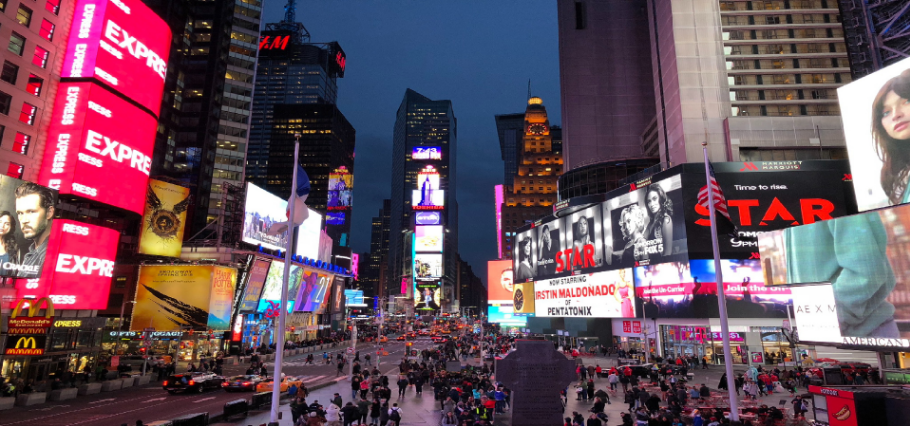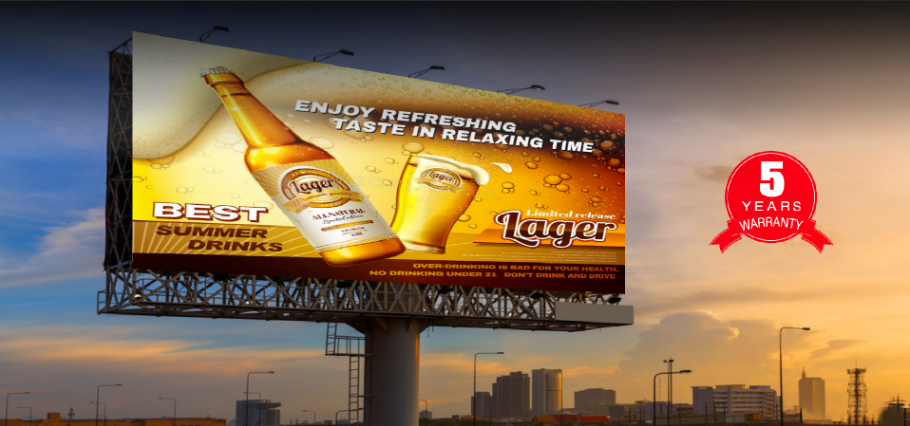Things You Should Know About Outdoor LED Billboards
What is an Outdoor LED Display/Screen?
An Outdoor LED display, often referred to as a billboard, integrates visual graphics and text to serve as a type of signage. Its primary function is to convey the purpose or name of a place, catering to both commercial and non-commercial objectives.
The prevalence of outdoor LED advertising screen has rendered it an essential foundational element in business. These displays offer a swift means to communicate the services and products available at a location, thereby reducing the time customers spend searching for their desired offerings in the market. In highly competitive business areas, attention-grabbing or intriguing billboards confer a competitive edge. Moreover, luxurious billboards serve as a visual representation of a business's financial strength, instilling preconceived notions in customers and bolstering confidence in the company.
Standardized billboards featuring the same specifications and uniform content within a chain store system foster a sense of connection among customers. This consistency implies that merchants belong to the same system, ensuring a uniform quality and standardization of services and products. However, creating an impactful billboard involves significant costs, prompting consumers to inquire about the expenses associated with these displays.
Consequently, the cost of billboards has become a paramount concern for all consumers.
What are the Advantages of Digital Out of Home Advertising?
1. Enhanced Targeting:Digital Out of Home advertising offers better targeting capabilities, allowing advertisers to display ads during times when the target audience is most likely to see them.
2. Measure Campaign Effectiveness: This form of advertising enables the measurement of campaign effectiveness through various means such as mobile location data or utilizing GPS, Wi-Fi, and 4G sensors, providing valuable insights.
3. Efficient Mobile Retargeting: Utilizing geofencing or creating virtual geographic boundaries around boards using GPS or RFID technology, advertisers can trigger personalized messages when a mobile device enters or exits the board's vicinity, enabling effective retargeting.
4. Creative Campaigns: Advertisers and agencies can unleash creativity to develop engaging campaigns that combat banner blindness, ensuring higher ad engagement.
5. Dynamic Content Delivery: Digital Out of Home ads can provide live content to consumers, including public transport schedules, directions, flight arrivals, weather updates, sports scores, and more.
6. Interactive Brand Communication: This form of advertising facilitates immersive and interactive brand communication, enabling direct engagement with the audience for a more impactful advertising experience.
Factors to Consider When Purchasing an Outdoor Advertising Screen Apart from Cost:
Product Quality:
Outdoor LED screens are frequently exposed to harsh elements like sunlight, rain, and dust carried by the wind. These screens operate in challenging environments where electronic components can become wet or excessively damp, leading to short circuits, failures, or even fires, resulting in substantial losses.
Additionally, the fluctuating temperatures in the working environment pose challenges. The display screens themselves generate heat during operation. If the ambient temperature is too high and there's inadequate heat dissipation, the integrated circuits may malfunction or even burn out, rendering the display system inoperable. While aiming to save costs, it's crucial not to compromise on the product's quality, as neglecting this aspect can potentially lead to safety hazards.
Flow:
From a marketing perspective, the flow of people is the foremost criterion in determining the placement of outdoor billboards. The fundamental goal of outdoor advertising is maximum visibility. The volume of traffic dictates the number of individuals who will view your advertisement.
Therefore, when selecting the installation site for a billboard, careful consideration of both pedestrian traffic and the field of view is crucial. Failing to do so might result in substantial spending without achieving the desired advertising impact.
Furthermore, the advanced technology and operational expenses associated with outdoor LED large screens imply their suitability for mid-to-high-end advertising campaigns.
A helpful suggestion: Outdoor LED large screens are primarily situated in the city's core CBD (Central Business District), along high-traffic roads, and in upscale residential areas. This diversity in placement options provides advertisers with rich and precise targeting opportunities.
Billboard Cost:
The expense of an outdoor large LED screen itself is notably high, along with relatively elevated maintenance and installation costs. Hence, ample budget preparation is necessary when contemplating advertising promotion through an outdoor large screen. Despite this, opting for a cheaper billboard solely based on cost can pose significant security risks.
Installation location, installation field of view:
Outdoor LED large screens typically range from a few square meters to dozens or even hundreds of square meters, catering to a broad audience. Adequate visibility necessitates a wide field of view, considering substantial changes in ambient light, particularly when exposed to direct sunlight, as it can significantly impact the display effectiveness.
Essential Characteristics of a High-Quality Outdoor LED Screen:
1. Strong Applicability: A superior outdoor LED display necessitates a unique design that suits outdoor environments with high brightness. Its protective design should withstand water and sunlight to a considerable extent, ensuring adaptability to outdoor scenes.
2. High Brightness: Top-tier outdoor LED screens employ ultra-high-brightness LEDs, ensuring clear visibility even from a considerable distance, particularly under intense sunlight.
3. Excellent Visual Effect: Incorporating point-by-point correction technology, these screens produce clearer images with enhanced depth and dimensionality, resulting in a stronger visual impact.
4. Robust Reliability: Utilizing static scanning technology and modular design, these screens boast higher reliability and stability, ensuring consistent performance over time.
5. Diverse Display Modules: A quality outdoor LED screen supports multiple display modes, enhancing versatility and catering to various content needs.
6. User-Friendly Operation: The use of standard video playback software facilitates convenient operation, making it easily manageable for users.
Precautions for Installing an Outdoor LED Screen:
Firmness:
When installing an outdoor LED large screen, ensuring the steel frame structure's robustness is crucial to withstand wind and seismic forces. Given the typically expansive installation areas in densely populated locations, the steel structure's design should meticulously consider factors such as foundation strength, wind load resistance, waterproofing, dustproofing, moisture resistance, ambient temperature considerations, lightning protection, and surrounding population density.
Therefore, the implementation phase necessitates comprehensive design drawings for the entire outdoor screen steel structure. These drawings must undergo review and approval by the relevant government department to guarantee the reliability and safety of the entire steel structure.
Waterproofing and Moisture Protection:
Outdoor LED displays are exposed to various adverse weather conditions like rain and snow, and internal moisture can lead to short circuits or fires, resulting in significant losses. Hence, strict waterproofing measures for the screen body and joints interfacing with the building are imperative. Implementing effective drainage systems within the screen body ensures proper water discharge during accumulation, emphasizing the importance of waterproofing and moisture-proofing. Notably, the protection level (front/back) of outdoor LED displays should be at least IP65, maintaining this level or higher for adequate protection.
Ventilation and Heat Dissipation:
Installation of ventilation equipment in outdoor digital display facilitates adequate cooling, maintaining internal temperatures between -10 ℃ to 40 ℃. Operational use generates heat, and in high-temperature environments, poor heat dissipation can lead to abnormal functioning or even circuit burnout, impairing the LED display system's performance.
Lightning Protection:
Comprehensive lightning protection measures are essential. Proper grounding for both the LED body and its shell is crucial. Inadequate lightning protection exposes the outdoor LED screen to various risks, as lightning strikes can cause substantial damage if protection measures are insufficient.
Usage of Large Outdoor LED Screens:
Adaptability:
Large outdoor LED screens boast high adaptability, requiring specialized designs suitable for outdoor settings with high brightness. Their unique protective designs allow them to withstand water and sunlight to a considerable extent.
High Brightness:
Premium outdoor LED screens utilize ultra-high-brightness LEDs, ensuring clear visibility even from long distances, especially under intense sunlight.
Visual Excellence:
Incorporating point-by-point correction technology enhances image clarity and creates a stronger sense of depth and hierarchy in displayed content.
Reliability:
Utilizing static scanning and modular design technologies ensures higher reliability and stability in operation, minimizing potential disruptions.
Diverse Display Capabilities:
These screens support multiple display modes, offering versatility in showcasing various types of content.
Ease of Operation:
Utilization of standard video playback software simplifies operations, making them user-friendly and easily manageable.
How Much Does a Billboard Cost?
Numerous factors influence the pricing of billboards, particularly when considering the purchase of an outdoor led billboard. Budget considerations should encompass the following aspects:
1. Display Screen Area: Larger LED display screens consume more materials, naturally driving up the price.
2. LED Display Specifications and Models: The "P" in LED displays denotes the center-to-center spacing between two adjacent pixels, known as dot spacing. Greater density of lamp beads results in a clearer display with higher resolution, thus elevating the price.
3. Materials Utilized in the LED Display: The quality of LED materials significantly impacts the display cost. Different chips exhibit varying stability, brightness, and lifespan, influencing overall pricing.
In essence, billboards yield substantial commercial value, and outdoor large screen technology continues to advance. When contemplating a billboard purchase, factors such as size, installation location, required resolution, among others, should be taken into account rather than solely focusing on the billboard's cost.










Leave a comment